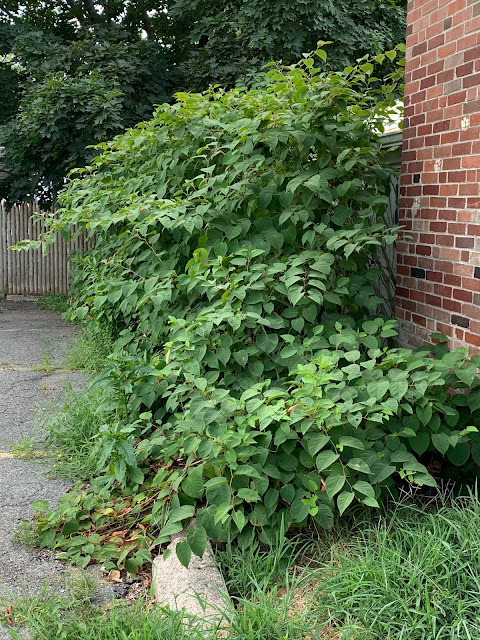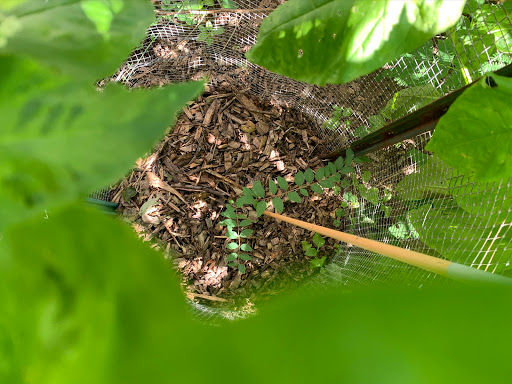One of the techniques I’m using to control invasive plants in the garden is planting vigorous growers, preferably natives, to claim their space. Invasives love disturbed ground. If I pull them out and leave the soil open to falling seeds or probing roots, I’ll have to do the same job over again. Rather than spending my gardening time fighting off invaders, I prefer to fill the garden with so many successful plants that invasives can’t find a foothold. At least that’s the theory.
I’m trying this competitive approach to keep out Japanese knotweed (Polygonum cuspidatum). Wherever there’s a patch of bare soil, this highly successful nonnative forms tall thickets that crowd out native plant communities.

Japanese knotweed is the ultimate opportunist
In my yard, Japanese knotweed pops up along the fence line every year, and I do my best to root it out. This will never be a permanent solution, because no one’s trying to eradicate it from the yards that abut mine. Rhizomes will keep spreading under the fence.
Knotweed multiplies by creating a thick, rapidly expanding mat of roots. If I cut the roots without removing the whole stand of knotweed, I’m actually stimulating more growth.
This spring I decided to fight fire with fire. I planted a coralberry (Symphoricarpos orbiculatus) next to where knotweed keeps emerging along the back fence.
 |
| Coralberry-photo Severnjc |
This native shrub is known as a suckering spreader. Most write-ups focus on how to keep it in check rather than how to coax it to grow. I’ll encourage coralberry to form a thicket to keep the knotweed from pushing its way into the yard. This summer the young coralberry is slowly expanding, despite being shaded by the fence and some giant pokeweeds (Phytolacca americana).
 |
| Coralberry guarded by tall pokeweeds |
Not all the aggressive growers that I need to beat back are state-certified nonnative invasive plants. Those are certainly a problem, but some of the too-vigorous plants in my yard are natives, such as smooth Solomon’s seal (Polygonatum biflorum). Native plants can range from shy to aggressive too, just like imported plants, as I learned the hard way.
 |
| Smooth Solomon's seal taking over |
I chose smooth Solomon’s seal because it was recommended for shade. Thirty years later, it’s taken over large areas in the shade of large trees and shrubs. It doesn’t do this in every garden; it’s just found growing conditions in my yard that suit it all too well.
I’m making a start at reducing the smooth Solomon’s seal population by pulling out its thick storage roots and planting vigorous growers in their place. I’ve had modest success encouraging preexisting clumps of a less-aggressive European cousin, variegated Solomon’s seal (Polygonatum odoratum var. pluriflorum ‘Variegatum’), to take over where the native had been king.
 |
| This variegated version is a nice alternative to aggressive smooth Solomon's seal. I'm ignoring the lilies of the valley, also spreading aggressively. |
A spreading clump of pawpaw (Asimina triloba), a small native tree, is shading out some of the smooth Solomon’s seal, with the side benefit of producing delicious edible fruit. Under the pawpaw’s shade, smooth Solomon’s seal isn’t sending up so many new plants. Now how to keep the pawpaw from taking over?
 |
| The pawpaw is forming a growing patch, worth it for the fruit |
,
No comments:
Post a Comment